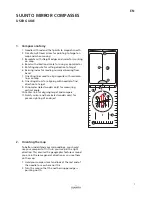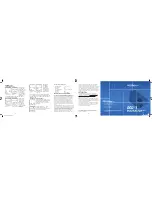
3
4. Select a visible target in front of you to help you
maintain your direction while travelling.
5. Follow your progress by comparing landmarks to the
map.
4. Measure distance on map
Your Suunto compass has multiple scales on the
baseplate to help you measure distance on a map. Be
sure to use the same scale indicated on your map. If the
map scale is not on your compass, use a general scale
(cm or inch) to calculate distance.
5. Declination correction
The meridian lines on a map indicate the direction
toward true north while your compass needle indicates
the direction toward magnetic north. The angle
between these two directions is called magnetic
declination.
Before navigating you should check your local magnetic
declination from a trusted source, such as a recent map
or the NOAA website. If the magnetic declination is
more than a few degrees, you must compensate for it
when navigating.
If your Suunto compass has a fixed declination scale, do
the following each time you navigate to a new target.
1. Follow ‘Navigate with map and compass’ procedure
to the end of step 3.
2. Turn left or right until the needle points to the
degree of declination on the fixed scale according to
your current location.
20
4
0
60
8
0
1
00
12
0 1
40
1
60
1
80
20
0
22
0
2
40
2
60
28
0
300 320 340
20
4
0
60
8
0
1
00
12
0 1
40
1
60
1
80
20
0
22
0
2
40
2
60
28
0
300 320 340
B
N
S
E
W
B
A
20
40
60
8
0
1
00
1
20
1
40
16
0
180
200
22
0
2
40
2
60
2
80
3
00
32
0
34
0
1:20000
20
40
60
8
0
1
00
1
20
1
40
16
0
180
2
00
2
20
24
0
26
0
28
0
3
00
3
20
3
40
IIII
IIIII
IIIIII
IIIIIII
IIIIIIIIIIIIIIIIIIIIIIIIIIIIIIIIIIIIIII
IIIIIIII
II










